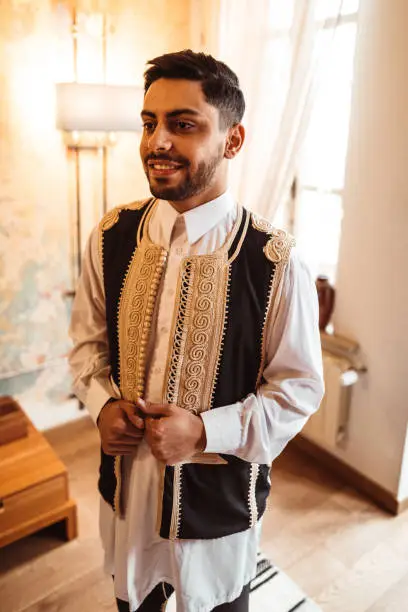What Is a Jabador?
The Jabador is a traditional North African two-piece outfit worn predominantly in Morocco, comprising a loose tunic paired with matching trousers. It is a staple garment that reflects both cultural pride and refined elegance. Often mistaken for the djellaba or kaftan, the Jabador stands apart for its unique silhouette and versatility.
Historically crafted with rich materials like cotton, silk, or brocade and adorned with hand-stitched embroidery, the Jabador is more than just attire—it is a reflection of heritage and identity. Today, it’s embraced globally, particularly by men seeking modest yet stylish wear for special occasions.
Cultural Origins of the Moroccan Jabador
The Moroccan Jabador has its roots in the Andalusian-Moorish era, influenced by Islamic and Berber aesthetics. Traditionally worn by dignitaries and aristocrats, the Jabador for men evolved to become a wardrobe essential for Moroccan families—especially during religious festivals, weddings, and formal gatherings.
Over time, regional variations emerged. For example, in northern Morocco, embroidery patterns differ from those seen in Marrakech or Fez. Still, the key features remain: a long tunic with side slits, detailed neckline embroidery, and trousers (serouel) that taper near the ankle. These characteristics make the mens Jabador a timeless classic that balances function with form.
The Rise of the Jabador in the UK
In recent years, the Moroccan Jabador UK scene has grown significantly. With the rise of modest fashion and increased visibility of North African culture in the West, the Jabador men trend is now prominent in British Muslim communities. Whether it’s Eid, Jummah, Nikah ceremonies, or even upscale dinner parties, UK-based brands and stores are now curating selections tailored for Western consumers.
Men across the UK are increasingly turning to the Jabador for men as a refined alternative to suits and sherwans. Its relaxed yet elegant appearance appeals to those who appreciate heritage fashion with a modern twist.
Retailers like Muda Paris have made Moroccan Jabador for men accessible to UK buyers, offering contemporary colour palettes and sizing suited to Western tastes. At the same time, many brands stay true to the traditional craftsmanship that makes the jabador special—such as intricate sfifa (braiding), hand-stitched embroidery, and matching accessories like belts or selham cloaks.
Styling the Mens Jabador for Modern Occasions
The beauty of the Jabador for men lies in its versatility. Whether it’s a grand wedding or a spiritual event, the Jabador Moroccan set adapts effortlessly to the tone of the occasion.
For Formal Events
Choose a Moroccan Jabador for men crafted in silk, velvet, or brocade. Opt for deep, regal tones like navy, emerald green, or burgundy. Detailed embroidery in gold or silver thread adds elegance. Pair it with leather slippers (babouches), a tarbouche (fez), and a tailored over-garment such as a selham for a refined, traditional look.
For Casual Settings
A lightweight cotton or linen jabador men set works well. Earthy neutrals like cream, sand, or light grey are subtle yet stylish. These are ideal for Jummah prayers, family visits, or casual outings. You can dress it down with loafers or open sandals.
Layering for UK Weather
In the UK, layering is key. Combine your jabador kaftan men set with tailored coats or wool cloaks. In winter, a wool selham or long overcoat over your jabador preserves modesty while adding warmth.
For summer, the breathable design keeps you cool while maintaining the elegant aesthetic.
Key Features That Define the Jabador Kaftan Men
- Embroidery (Sfifa): Handcrafted sfifa embroidery is the hallmark of a quality jabador Moroccan. Whether on the chest, cuffs, or collar, the detailing reflects both skill and
- Loose Tunic: Typically collarless with an open neckline, the tunic falls just below the knee and is designed for airflow and comfort.
- Tapered Trousers (Serouel): Worn underneath the tunic, these are cut wide at the top and narrow at the ankles—offering comfort with a polished silhouette.
- Breathable Fabrics: High-quality cotton, silk blends, or light wool fabrics are most commonly used depending on the season and occasion.
FAQs: Understanding the Jabador Better
Is the jabador only worn by Moroccans?
While it is a Moroccan cultural garment, the jabador men’s style has become popular globally among those seeking elegant, modest wear.
When is the best time to wear a Moroccan Jabador in the UK?
The men’s jabador is perfect for a variety of occasions—from Eid prayers, Nikah ceremonies, and Jummah to weddings and evening gatherings. Its versatile style means you can dress it up or down depending on the event, making it an essential part of any modestwear wardrobe.
What’s the difference between a jabador and a djellaba?
A djellaba is a long, hooded robe worn over clothing, while the jabador is a two-piece tunic and trousers set, often more decorative.
Are jabador sets customisable?
Yes. Many online stores and local tailors offer custom fits, embroidery styles, and fabric choices, especially in the Moroccan Jabador for men UK market.
How do I care for a jabador?
Always follow fabric care labels. Silk or embroidered jabador men’s sets should be dry cleaned. Cotton versions can usually be machine-washed on a delicate cycle.

